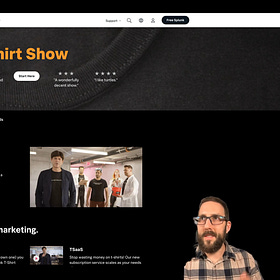Content comes in many different flavors, and while we always prioritize what channels to invest in based on where our audiences are, the message and position are the key differentiators for this course.
Please reference our syllabus here. You can find the brand audit template here.
In demand-based content, you can appeal to researchers trying to solve a problem or find a better way to solve it.
You can speak towards saving time and money.
You can highlight customer stories about what they were able to accomplish with your solution.
These are all content types that increase demand for your solution.
Conversely, thought leadership content can be simplified into two vectors and fits well between demand gen content and brand awareness: building expertise behind key employees, proving expertise in your industry through external subject matter experts, and investing in research. That research can be as simple as developing a hypothesis and mapping it to a survey of your audience or tapping into a data lake of your user data.
And that brings us to brand awareness.
We’ve covered this ad nauseam, but brand awareness campaigns and content should focus on the company's vision, mission, values, and impact and offer a story that appeals to all audiences. No segmentation, no balancing a story based on how large or small they are. One message to rule them all! Easy, right? Not exactly.
We discussed Nike and Dove as key examples in module 5 because they have mastered the art of brand storytelling. Unfortunately, these don’t directly correlate to cybersecurity brands because the emotions we invoke are more intense, highly scrutinized, and have highly intelligent people in the mix. There, of course, is the exception of B Corps, which focuses on being profitable at the same time as offering a positive impact on the world; that would make this whole branding thing super easy, but it’s not common.
So what does that leave us?
We look back at the values we stand for, personify them, build a story around them, and you’re off to your first story. For most of us, that means we want to hone in on being trustworthy and understanding, investing in shared success (through advanced tech and processes), being available, and simplifying efforts. Let’s go down the rabbit hole a bit to explore how some of this works.
Lastly, the channels and content types you choose impact the story you tell. I realize that is pretty obvious, so rather than boiling the ocean and saying a brand campaign will encompass everything, start small and expand as you find success. A brand video is typically a good starting point, especially if you can chop it up for social, use photos on blogs and landing pages… you get the point.
As far as determining the channels and content types, we can loop back around to our favorite concept: validate, validate, validate. If your audience is there and engaged, it is worth testing out. Does this mean you should consider a branded Twitter/X campaign because your audience USED to be there? Probably not. Does it mean you should open a Threads account without first doing a bit of research? Also no. Go where your audience is first, then test other channels.
Centralize Your Brand Story
You’ve got your brand campaigns and strategies down, but how do we refine these concepts further? This lesson is about tips to enhance what you may be doing today or will be doing as you invest further in brand awareness campaigns. Please reference our













Share this post